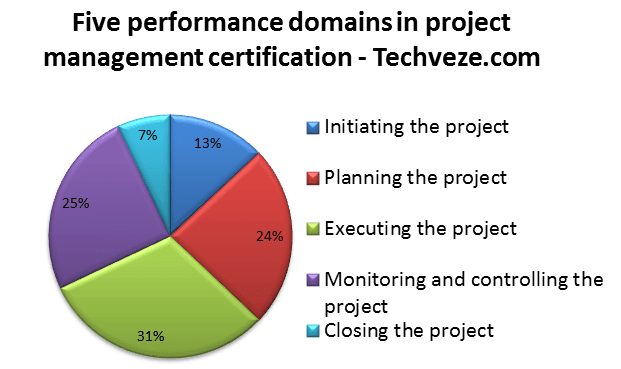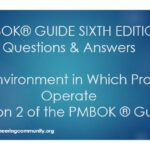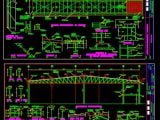
PMP®️ Domain Information & Overview
6 January 2019Table of Contents
PMP®️ Domain Information & Overview
Introduction
Welcome back to this series on the Project Management Professional (PMP)®️ certification. In this article, we will cover everything you need to know about the domains/performance areas covered in the PMP examination.
First off, let’s start with an explanation of what domains are.
What Domains Are Covered on the PMP Exam?
Project management is defined as the application of knowledge, skills, tools and techniques to project activities/tasks to meet project requirements. The project activities/tasks a project manager has to perform are divided into five performance areas or domains. These are the five domains that are covered in the PMP exam to ensure you have all the competencies needed to successfully manage any project.
The domains are:
Initiating
This domain covers defining a new project or phase and initial scope, getting authorization, getting initial financial commitment and identifying stakeholders.
Planning
This domain covers defining the scope, objectives and a clear course of action that will be taken to achieve the objectives. All the planning information is stored in the project management plan, which often needs to be revisited if a change happens.
Executing
This domain covers executing the work defined in the project management plan, coordinating people and resources.
Monitoring and Controlling
This domain covers tracking and reviewing the progress and performance of the project and initiating changes if necessary.
Closing
This domain covers finalizing all activities and formally close the project. It may involve getting client acceptance and documenting lessons learned or changes to assets.
How Often Are the Domains Updated?
In order to ensure that the Project Management Professional certification evolves with the profession and reflects competencies needed by present-day project managers in their day-to-day activities, the Project Management Institute (PMI®️) conducts role delineation studies (job analysis) every five to seven years (PMP Certification Handbook, 2017). The role delineation study is performed by an independent party and is validated by volunteer project managers all over the world.
The outcome of the role delineation study may indicate changes to the terminology, tasks, knowledge and skills needed by project managers. This will result in an update to the domains, which domains are most important and how many questions are allocated within each domain in the PMP examination. The changes to the domain are outlined in the PMP exam content outline, which was last published in June 2015. A change in the PMP exam content outline results in a change in the PMP exams.
It is important to note that even though the PMP exam is based on the PMP exam content outline, sometimes the PMP exam also changes even when the exam content outline does not change: for example, when a new edition of the Project Management Book of Knowledge (PMBOK) is released. The PMP exam was last updated on March 26, 2018
How Much is Each Domain Worth on the Exam?
The number of questions from each domain in the PMP exam depends on the outcome of the last role delineation study and which areas are considered most important.
The exam has 200 multiple-choice questions. 175 of them are scorable while the remaining 25, called pre-test questions, are not. Pre-test questions allow PMI to monitor the question performance before adding them to the official exam questions. The 175 scorable questions are broken down into the following percentages:
Initiation: 13%
Planning: 24%
Executing: 31%
Monitoring and Controlling: 25%
Closing: 7%
What Topics Are Covered in Each Domain?
PMP Domains are groups of tasks that the project manager needs to do in order to manage projects and the knowledge or skills needed to do these tasks efficiently. Some of these knowledge areas and skills cross multiple domains and tasks. In this section, we will outline which tasks, knowledge areas and skills are needed in each domain.
Domain 1: Initiating
The first domain on the PMP is called Initiating. The aim of this domain is to test your ability to perform the tasks needed to initiate a project or a phase of a project. Before a project can start, it needs to be determined that the idea for the project and its main objectives are feasible. The project manager then needs to perform several tasks to ensure the project can be completed effectively and get approval to start the project. There are eight tasks within the initiating domain. They are:
- Performing project assessment to determine feasibility
- Identifying key deliverables based on business requirements
- Performing stakeholder analysis
- Identifying high-level risks, assumptions and constraints
- Developing the project charter
- Getting approval of project charter from sponsor
- Conducting benefit analysis with relevant stakeholders
- Informing stakeholder of approved project charter
Specific knowledge and skills needed in this area include: analytical skills, benefit analysis techniques, elements of a project charter, estimation tools and techniques and strategic management.
Domain 2: Planning
The second domain on the PMP is called Planning. The aim of this domain is to test your ability to perform tasks needed to outline a clear course of action for achieving the objectives of the project. For example: creating a schedule, determining how finances will be managed, determining how change will be managed and so forth. All the planning information is stored in the project management plan. There are 13 tasks within the planning domain:
- Reviewing and assessing detailed project requirements, constraints and assumptions with stakeholders
- Developing a scope management plan
- Developing a cost management plan
- Developing the project schedule
- Developing the human resource management plan
- Developing the communications management plan
- Developing the procurement management plan
- Developing the quality management plan
- Developing the change management plan
- Developing the risk management plan
- Presenting the project management plan
- Conducting the kick-off meeting and communicating relevant information
- Developing the stakeholder management plan
Specific knowledge and skills needed include: change management planning, cost management planning, inclusion of project budgeting tools and techniques, communications planning, contract types and selection criteria, estimation tools and techniques, human resource planning, lean and efficiency principles, procurement planning, quality management planning, requirements gathering techniques (e.g., planning sessions, brainstorming and focus groups), regulatory and environmental impacts assessment planning, risk management planning, scope deconstruction (e.g., WBS, scope backlog) tools and techniques, scope management planning, stakeholder management planning and time management planning, including scheduling tools and techniques and workflow diagramming techniques.
Domain 3: Executing
The third domain on the PMP is called Executing. The aim of this domain is to test your ability to perform the tasks needed to carry out the course of action set out in the project management plan. The project manager needs to coordinate resources, ensure they understand and implement the plan, manage how project information is communicated and manage the relationship with stakeholders. There are seven tasks within the executing domain. They are:
- Acquiring and managing project resources by following the human resource and procurement plan
- Managing task execution based on the project management plan
- Implementing the quality management plan
- Implementing approved changes and corrective actions by following the change management plan
- Implementing approved actions by following the risk action plan
- Managing the flow of information by following the communication plan
- Manage stakeholder relationship by following the stakeholder management plan
Specific knowledge and skills needed include: continuous improvement processes, contract management techniques, elements of a statement of work, interdependencies among project elements, project budgeting tools and techniques, quality standard tools and vendor management techniques.
Domain 4: Monitoring and Controlling
The fourth domain on the PMP is called Monitoring and Controlling. The aim of this domain is to test your ability to perform the tasks needed to track and review the progress and performance of the project. The project manager needs to do everything necessary to make sure the project is on track and that deliverables meet the expected standard. There are seven tasks within the monitoring and control domain. They are:
- Measuring project performance
- Managing changes to project following change management plan
- Verifying that project deliverables conform to the standards in the quality management plan
- Monitoring and assessing risks
- Reviewing issue logs
- Capturing and analyzing lessons learned
- Monitoring procurement activities according to the procurement plan
Specific knowledge and skills needed include: performance measurement and tracking techniques (e.g., EV, CPM, PERT, trend analysis), process analysis techniques (e.g., LEAN, Kanban, Six Sigma), project control limits (e.g., thresholds, tolerance), project finance principles, project monitoring tools and techniques, project quality best practices and standards (e.g., ISO, BS, CMMI, IEEE), quality measurement tools (e.g., statistical sampling, control charts, flowcharting, inspection, assessment), risk identification and analysis techniques, risk response techniques and quality validation and verification techniques.
Domain 5: Closing
The fifth and last domain on the PMP is aptly called Closing. The aim of this domain is to test your ability to perform tasks needed to finalize all activities and formally close the project. The project manager needs to ensure that the client accepts the deliverables and document lessons learnt for future projects. There are seven tasks within the closing domain. They are:
- Obtain final approval of project deliverables from relevant stakeholders
- Transfer ownership of project deliverables to assigned stakeholders
- Obtain financial, legal and administrative closure
- Prepare and share final project report according to the communications management plan
- Collate lessons learned and conduct a project review
- Archive project documents and materials
- Obtain feedback from relevant stakeholders
Specific knowledge and skills needed include: archiving practices and statutes, compliance (statute/organization), contract closure requirements, close-out procedures, feedback techniques, performance measurement techniques (KPI and key success factors), project review techniques and transition planning techniques.
Further knowledge areas and skills
There are additional knowledge and skills that cut across all 5 domains. They include: active listening; applicable laws and regulations; benefits realization; brainstorming techniques; business acumen; change management techniques; coaching, mentoring, training and motivational techniques; communication channels, tools, techniques and methods; configuration management; conflict resolution; customer satisfaction metrics; data-gathering techniques; decision-making; delegation techniques; diversity and cultural sensitivity; emotional intelligence; expert judgment technique; facilitation; generational sensitivity and diversity; information management tools, techniques and methods; interpersonal skills; knowledge management; leadership tools, techniques and skills; lessons learned; management techniques; meeting management techniques; negotiating and influencing techniques and skills; organizational and operational awareness; peer-review processes; presentation tools and techniques; prioritization/time management; problem-solving tools and techniques; project finance principles; quality assurance and control techniques; relationship management; risk assessment techniques; situational awareness; stakeholder management techniques; team-building techniques; and virtual/remote team management.
Conclusion
I hope this has given you a better understanding of the PMP domains and what they cover. Future article topics will be focusing on the each of the PMP domains and going into more details about their respective tasks, knowledge and skills.
Sources
Project Management Professional (PMP)®️ Handbook, PMI
Project Management Professional (PMP)®️ Examination Content Outline, PMI
To download Free Project Management Templates you can visit www.managementproject.net








